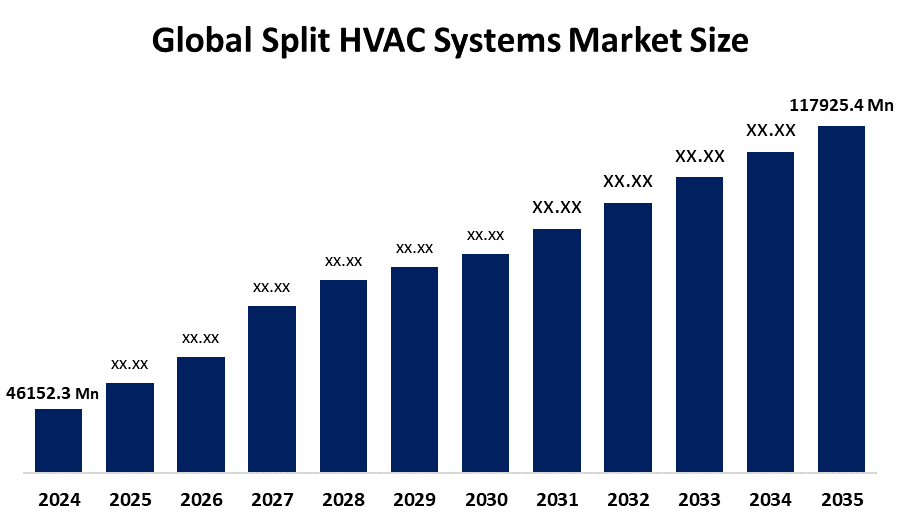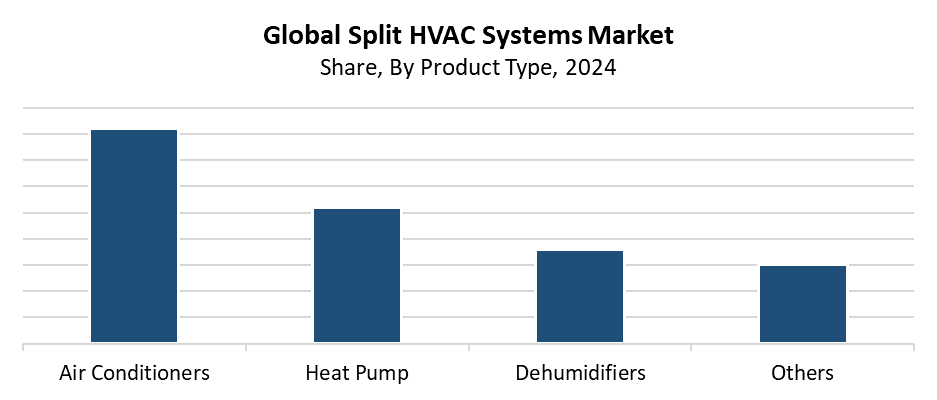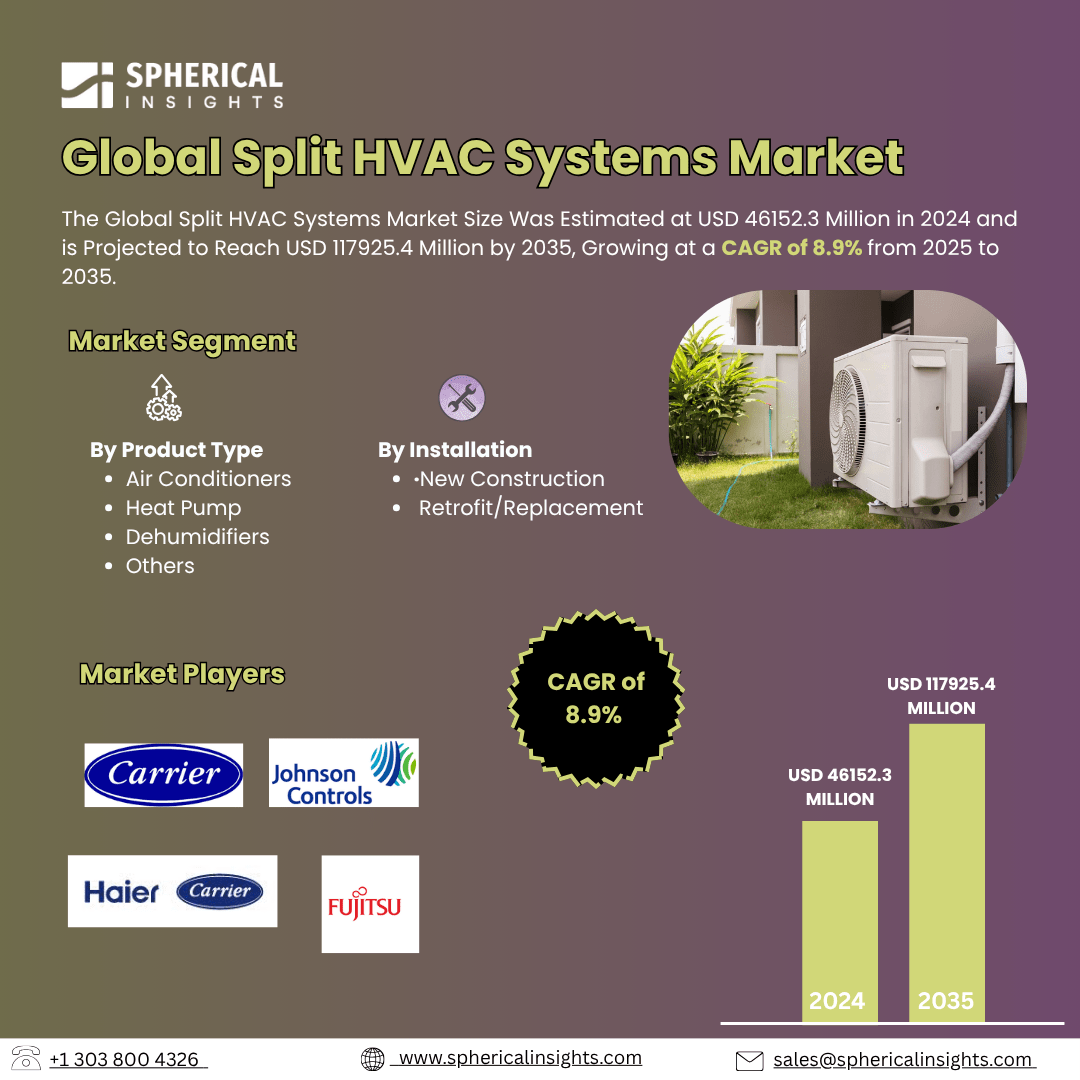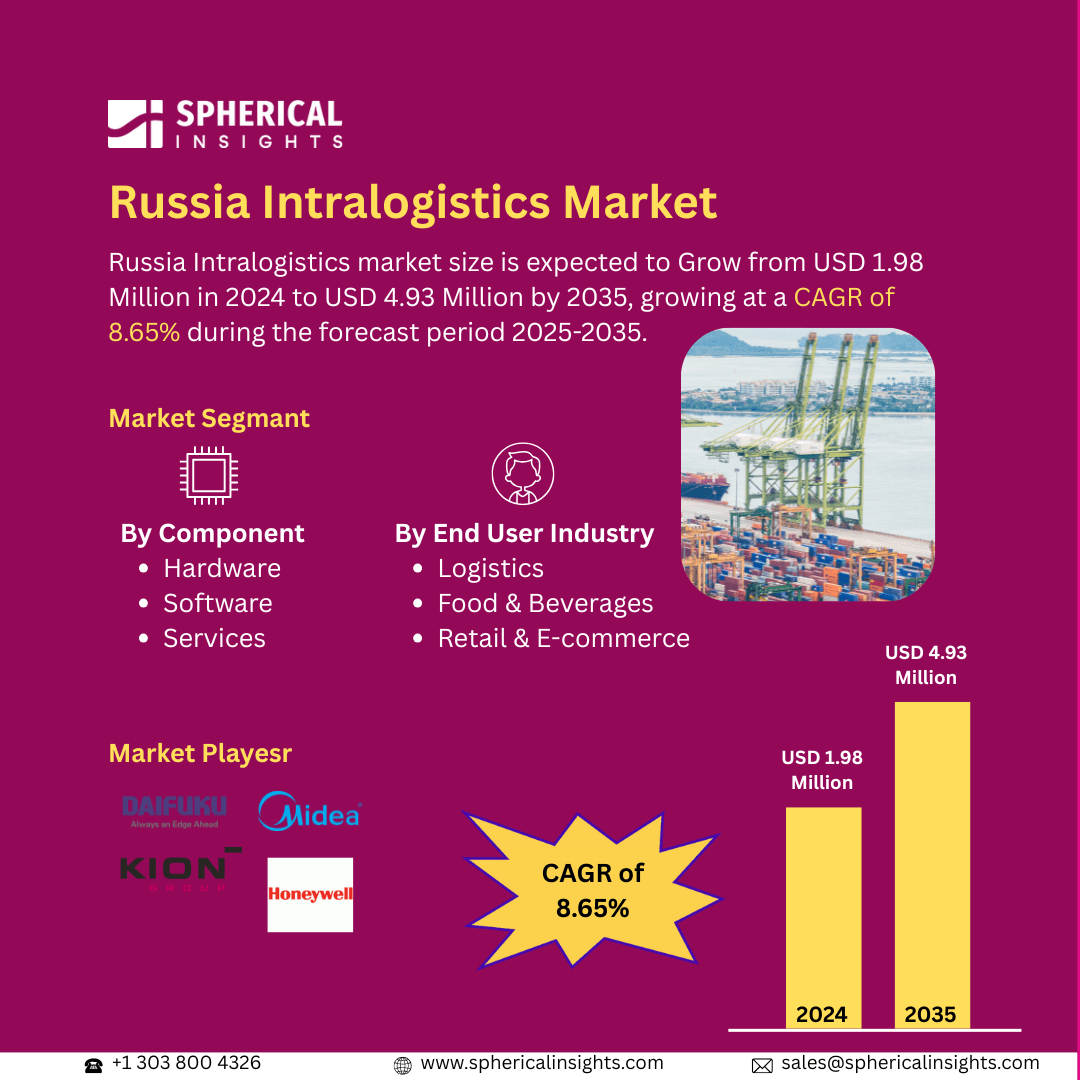Split HVAC Systems Market Summary
The Global Split HVAC Systems Market Size Was Estimated at USD 46152.3 Million in 2024 and is Projected to Reach USD 117925.4 Million by 2035, Growing at a CAGR of 8.9% from 2025 to 2035. The market for split HVAC systems is expanding as a result of the growing need for energy-efficient cooling solutions, expanding urbanisation, rising residential and commercial construction, technological advancements, rising temperatures brought on by climate change, and government incentives supporting environmentally friendly and sustainable air conditioning systems.
Key Regional and Segment-Wise Insights
- In 2024, the Asia Pacific split HVAC systems market held the largest revenue share of 46.7% and dominated the global market.
- In 2024, the air conditioners segment held the highest revenue share of 41.5% and dominated the global market by product type.
- With the biggest revenue share of 59.6% in 2024, the retrofit and replacement segment led the worldwide split HVAC systems market by installation.
Global Market Forecast and Revenue Outlook
- 2024 Market Size: USD 46152.3 Million
- 2035 Projected Market Size: USD 117925.4 Million
- CAGR (2025-2035): 8.9%
- Asia Pacific: Largest market in 2024

The market for split HVAC systems operates as a dedicated sector which delivers heating, ventilation, and air conditioning solutions through separate indoor and outdoor units to enhance air quality and temperature control efficiency. Because of their adaptability, energy efficiency, and silent operation, these systems are frequently found in residential, commercial, and industrial structures. The market grows because people need affordable, energy-efficient climate control solutions, and urban areas expand. Smart homes and commercial buildings continue to grow. The market expands because disposable income levels increase and because consumers want sustainable comfort solutions, and because of global climate changes. Furthermore, replacing outdated HVAC units with more modern split systems improves energy efficiency and lowers operating expenses.
The market for split HVAC systems is going through significant changes because of new technological developments. Modern systems now incorporate Variable refrigerant flow (VRF) technology with smart thermostats, inverter technology, and Internet of Things (IoT)-based controls to deliver remote monitoring capabilities while reducing energy consumption and boosting system performance. To support environmentally friendly HVAC systems, governments around the world establish energy-efficiency regulations and green building codes and create incentive programs. The development of energy labelling programs together with new low-GWP refrigerants promotes sustainable cooling alternatives. This drives split HVAC system innovation and worldwide expansion.
Product type Insights

The air conditioners segment held the largest market share of 41.5% and dominated the global split HVAC systems market during 2024. The worldwide requirement for efficient cooling systems across commercial, industrial, and residential sectors drives this market dominance. Split air conditioners have gained popularity as a cooling solution because they operate more efficiently than standard cooling systems, produce less noise during operation, and require simple installation procedures. The demand for modern structures continues to grow because of urban expansion and increasing personal wealth, and the construction of new buildings. The air conditioner segment of split HVAC systems maintains its market leadership because of technological progress, which includes environmentally friendly refrigerants and smart control systems. Inverter compressors enhance both sustainability and performance.
The heat pump segment is expected to grow significantly throughout the forecast period. The rising need for environmentally friendly, energy-efficient heating and cooling systems in residential and commercial buildings drives this market expansion. Heat pumps operate more efficiently than conventional HVAC systems because they perform both heating and cooling functions at reduced operational expenses. The growing public understanding of carbon reduction needs, together with government programs that promote sustainable and renewable technologies, drives up the demand for these solutions. System performance and reliability have advanced through technological progress, which includes variable refrigerant flow (VRF) systems and inverter-based compressors. Smart control systems. The heat pump market will experience major growth in the upcoming years because energy efficiency standards across the globe continue to tighten.
Installation Insights
The retrofit and replacement segment led the global split HVAC systems market with the largest revenue share of 59.6% in 2024. The need to replace old HVAC systems with modern energy-efficient units which deliver superior performance. This lowers operational expenses and drives this market leadership. Split systems of today serve as replacements for older systems in residential and commercial spaces because of increasing environmental regulations and government restrictions on energy consumption and pollution emissions. The market favours replacement units because of technological advancements that introduced environmentally friendly refrigerants, smart thermostats, and inverter technology. The segment maintains its strong market position and international growth through the rising number of building renovation and retrofitting projects, which occur mainly in developed areas.
The new construction segment is expected to grow at the fastest CAGR during the forecasted period. The quick expansion of residential, commercial, and industrial infrastructure across established and developing countries drives this growth. The growing trend of advanced split HVAC systems in new construction projects stems from three main reasons, which include urban expansion, together with higher household earnings and the need for modern energy-efficient structures. Builders and developers now choose intelligent, environmentally friendly HVAC systems with inverters to meet energy-efficiency standards and green building requirements. The government backs programs which promote low-emission cooling systems. These promote sustainable building methods to speed up industry growth. The new construction sector will keep its control over the split HVAC systems market as long as global construction activity continues to grow.
Regional Insights
The North American split HVAC system market will experience continuous growth throughout the forecast period because modernizing old HVAC systems and increasing requirements for energy-efficient temperature control systems. The United States and Canada lead the market because residential construction activities have increased, smart home technology adoption has grown, and government regulations support environmental sustainability and energy efficiency. The market shows an increasing trend toward smart split HVAC systems and inverter-based technology because these systems deliver better comfort and cost savings to consumers. The local weather conditions, together with carbon reduction initiatives, lead to system replacement and upgrading activities in the area. The North American split HVAC system market expands through technological advancements, which include environmentally friendly refrigerants.
Europe Split HVAC Systems Market Trends
The European market for split HVAC systems experiences significant growth because customers seek environmentally friendly and energy-efficient heating, cooling, and ventilation solutions. The strict EU rules for carbon reduction and environmentally friendly construction methods have driven Germany, France, the United Kingdom, and Italy to become leaders in this field. The area's growth depends on its focus on environmentally friendly building methods, together with the restoration of existing buildings and the shift to low-GWP refrigerants. The market growth depends on two main elements, which include higher spending on smart networked HVAC systems. Growing recognition of energy-saving practices also plays a role. The European shift toward environmentally friendly, energy-efficient infrastructure relies on split HVAC systems because these systems combine inverter technology with heat recovery systems and Internet of Things-enabled controls to deliver enhanced comfort and operational performance.
Asia Pacific Split HVAC Systems Market Trends
The Asia Pacific split HVAC systems market led globally with the largest revenue share of 46.7% in 2024. Major economies, including China, India, Japan, and South Korea, drive this market through their fast urban growth and industrial progress and expanding residential and commercial building activities. The market grows because people have more money to spend, and they understand energy conservation better and want comfortable indoor environments. The adoption process receives additional support from government initiatives, which promote energy-efficient technology. Sustainable building practices also support adoption. The market benefits from major HVAC manufacturers who develop eco-friendly refrigerants and smart controls, and inverter technology, which enhances system efficiency and lowers costs. The Asia Pacific region maintains its leading position in the global split HVAC system market because of these combined elements.
Key Split HVAC Systems Companies:
The following are the leading companies in the split HVAC systems market. These companies collectively hold the largest market share and dictate industry trends.
- Carrier
- Fujitsu
- Haier Group
- Johnson Controls
- Midea
- Daikin
- Trane
- Samsung
- Voltas
- Panasonic Corporation
- LG Electronics
- GREE Comfort
- Others
Recent Developments
- In June 2025, Haier expanded its market reach in Central and Eastern Europe by acquiring the Hungarian HVAC company KLIMA KFT. Haier is better positioned to provide environmentally friendly heating and cooling options in the area thanks to this acquisition. By fusing the creativity of Haier with the experience of KLIMA, it promotes improved customer service in the area.
- In March 2025, Panasonic Canada and EMCO HVAC teamed up to increase the accessibility of its energy-efficient heat pumps across the country. Panasonic will distribute its ducted and ductless heat pumps to residential markets across the country via EMCO's vast distribution network. The collaboration is currently in effect, and EMCO's nationwide branches offer the products.
Market Segment
This study forecasts revenue at global, regional, and country levels from 2020 to 2035. Decision Advisors has segmented the split HVAC systems market based on the below-mentioned segments:
Global Split HVAC Systems Market, By Product Type
- Air Conditioners
- Heat Pump
- Dehumidifiers
- Others
Global Split HVAC Systems Market, By Installation
- New Construction
- Retrofit/Replacement
Global Split HVAC Systems Market, By Regional Analysis
- North America
- Europe
- Germany
- UK
- France
- Italy
- Spain
- Russia
- Rest of Europe
- Asia Pacific
- China
- Japan
- India
- South Korea
- Australia
- Rest of Asia Pacific
- South America
- Brazil
- Argentina
- Rest of South America
- Middle East & Africa
- UAE
- Saudi Arabia
- Qatar
- South Africa
- Rest of the Middle East & Africa





